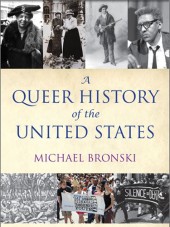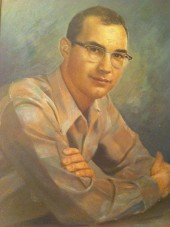 A Queer History of the United States: ReVisioning American History
A Queer History of the United States: ReVisioning American History
By Michael Bronski
Published by Harrington Park Press
Winner of a 2012 Stonewall Book Award in nonfiction
Published May 10, 2011
Nonfiction: LGBT History
213 pages; index
Find on Amazon.com:
Hardback ISBN: 0807044393
Paperback ISBN: 0807044652
Review by Billy Glover
Submitted May 11, 2011
I think most people will know my thoughts on this book and complain that I spend too much time trying to defend and get credit for ONE Inc./ ONE magazine, and the Homosexual Information Center. The truth is that apparently most people writing and speaking on the issue of homosexuality and the community and movement spend their time, either because they are incompetent and/or unethical, trying to hide the work of the most important organizations, people, and publications in the movement for its first decade, beginning in 1952.
It is hard to understand the motive behind this truly queer effort. It comes from people of all political persuasions/proclivities, Michael Bronski being only the most rent example. It takes deliberate effort and determination to say the word Mattachine, and skip to the Daughters of Bilitis with only a later mention of the lawsuit over the right to publish the first movement publication, ONE magazine. Bronski takes pains to give readers/students a long list of celebrities, books, and even goes so far as to take time and space to give the first name of a writer and then his new name, yet he sees no reason to mention the most important writer, journalist, and editor in the movement for the first two decades, one honored by the organization of gay and lesbian journalists in their Hall of Fame: Don Slater.
He never mentions the most important person (perhaps because he was working on the left coast) who did for the subject and movement’s history what Bronski has tried to do on the East Coast and in this book. Has he never heard of Jim Kepner or seen his work? It is still available in another part of the movement he ignores, the LGBT libraries/archives, in this case that of W. Dorr Legg and Jim Kepner’s parts of the first movement archives/library, ONE Institute, now at the library of USC.
He does cover some early publications, spending a lot of time on male physique magazines, yet he never mentions the first effort to combine that type of publication with the serious types such as ONE or DRUM, and he never mentions the most successful national publication-again from the West Coast, The Advocate.
I have said often that the success of the effort to change the nation’s view on homosexuality is owed to the few brave founders and the people who slowly started to join the effort, which led from only one small group to hundreds and hundreds of publications, covering all aspects of the issue of homosexuality.
And while I and others have said that other events and people also indirectly contributed to our success, I doubt many serious scholars would say that it was the media/celebrities, closeted authors, etc. who actually are the ones who got the world to hear us, and the movement was several decades old before any such people joined and “came out of the closet.” Yet most of the book implies that the famous did it all, since he devotes 3/4 of the book to naming them. It is truly a queer view of this subject that gives more mention of <blank> than to a man or woman who devoted their abilities and lives to get equal rights for us.
While the title of the book is about queer history, that would not be valid without the movement for homosexual rights. This civil rights movement may be the only one that is well-documented from its start. It began in Los Angeles in 1950 with a secret organization, early Mattachine, and became public in 1953 as ONE, Inc., and produced the first public, soon-to-be national publication in January of 1953, ONE magazine. No history can ignore thee facts. What “thinking” ignores this and gives page after page to celebrities who may or may not even be homosexual?
Bronski is giving us his particular version or understanding of history, which makes this more autobiography than a true history — he documents those things that most influenced him. But those who know better have a duty to correct him. For instance, why does he say Dr. Evelyn Hooker’s work had no affect on the psychological and psychiatric community? While he documents well the vicious anti-homosexual almost religious views of people like Bieber and Bergler, he ignores those who did start educating the world on the truth, such as Dr. Blanche M. Baker, whose work with ONE is amply documented?
Bronski is an educator, yet he gives no notice of the educational work of the movement started by a respected educator, a professor of education at USC, Merritt Thompson, who helped to set up ONE Institute. And how is it that his only reference to the main person behind this, W. Dorr Legg, is only mentioned as the “author” or editor of a book he credits, not as a primary source but a secondary source, as if he has no knowledge of the book except because some other writer mentions it (i.e., Homosexuals Today)? And is Legg identified as the co-founder, with Don Slater, Dale Jennings, et al. of ONE? No, only as a co-founder of a minor group (Knights of the Clock), and the only possible explanation of this distortion of Legg’s importance is that Bronski did not want to credit ONE but did want to cover early interracial groups.
And in that vein, he bewilders any one acquainted even a little with the history of this cause by mentioning the takeover: killing off of the founders of early Mattachine (the original Mattachine Foundation) and crediting this to a woman, Marilyn Riegers, and then never mentions the main person involved, Hal Call. To further distort the history, he mentions the LIFE magazine article on the movement in 1964 and covers the sexy gay bars part but ignores the picture of Hal Call and Don Slater (credited as being editors of two serious publications)—meaning LIFE gives a more balanced view of the movement than he provides.
While Bronski says others will wonder why he mentions some people and groups and not others, that gives no excuse to present what is supposed to be the record of how homosexuality and the movement got to where it is today without mentioning the largest LGBT organization, the Metropolitan Community Church, and its main founder, Troy Perry. It may be something to discuss, but most people would say that having several well attended “marches on Washington” was a very visual if not important event in the history of the movement.
The philosophical part of the subject he over-covers, with Plato, Emerson, Locke, and he rightly places their thinking as affecting both movements, that of our nation and our movement. He sees the parallel between bigots’ views on slavery and homosexuality, and the problem it is for those who want to make the Constitution a perfect document (and the same for the Bible).
He rightly sees wars as having an affect on where individuals live: leaving the controls of small towns, etc., an issue I don’t see is important since he mentions the legal aspects and court decisions on sexuality and race, and there is a question as to how much good those cases have done (meaning that if a law is needed, pro or con, you may have lost your cause). It is interesting to consider the results of some decisions on the nation, such as how fast we got change after Brown vs. Board, and Roe vs. Wade, and if the abortion issue is settled. (Has Brown even now been successful?) And on the other extreme, it is important to know why there was silence after Lawrence vs Texas. (Could it be that the movement had laid the groundwork for public acceptance of the decision?)
Bronski rightly says that a decision on birth control changed the legal and practical view of sex, separating it from reproduction. And that Loving vs. Virginia has relevance to our issue of marriage. And it is good to have him point out that some of the idols of americans of the old days, such as the Boy Scouts and Tarzan, were actually racist and anti-gay.
He gives Kinsey credit, and (I think rightly) implies that the anti-homosexual effort of people like Anita Bryant actually seemed to win a battle, but in reality they have lost the war. I don’t agree, though, that the hippies or Beats did that much for our cause. He, as it happened in the real world, increases the speed as he goes from the coverage of possible homosexuality from 1400s to a fast listing of the many people and events since 1990, and after Stonewall (i.e. the GLF and GAA).
He does seem to not give Frank Kameny credit for his work against the psychiatric guidelines, but for the sexy slogan gay is good. He rightly concludes that the more successful our cause has become, the greater the backlash as the bigots realize that they are on the defensive and their lies are no longer working.
He seems to say that AIDS did not harm our movement, even though we lost so many good people. He points out that in this decade we are finally starting to deal with the aspect of homosexuality that was always the most important: children. Yet he never credits such efforts as COLAGE, GLSEN, PFLAG, The Point Foundation, etc. He does say, rightly, that TV and movies are now pro and not anti — and GLEE, Jon Stewart, and Stephen Colbert are almost doing the entire work of the movement now.
Welcome to these “Mattachines” of today!
But the old discussion of which is worse, sins of omission or commission, applies. Bronski does both, thus giving a slanted an unbalanced of the subject while he might have wanted to finally give us view of the context of how we got where we are. Fortunately we have the LGBT media, which he also ignores, with good newspapers in every major city, along with LGBT centers in those cities.
Blurbs
A Queer History of the United States is more than a “who’s who” of queer history: it is a book that radically challenges how we understand American history. Drawing upon primary-source documents, literature, and cultural histories, scholar and activist Michael Bronski charts the breadth of lesbian, gay, bisexual, and transgender history, from 1492 to the 1990s.
About the Author
Michael Bronski, co-author of You Can Tell Just By Looking (Beacon, Oct. 2013), is senior lecturer in the Women’s and Gender Studies Program and in the Jewish Studies Program at Dartmouth College. He has written extensively on LGBT issues for four decades, in both mainstream and queer publications. His book Pulp Friction: Uncovering the Golden Age of Gay Male Pulps won a Lambda Literary Award in 2003.


